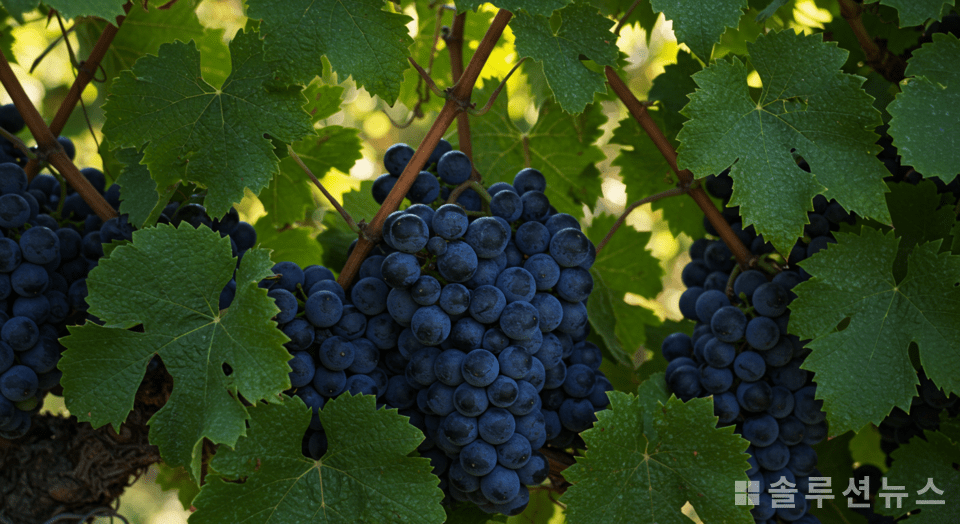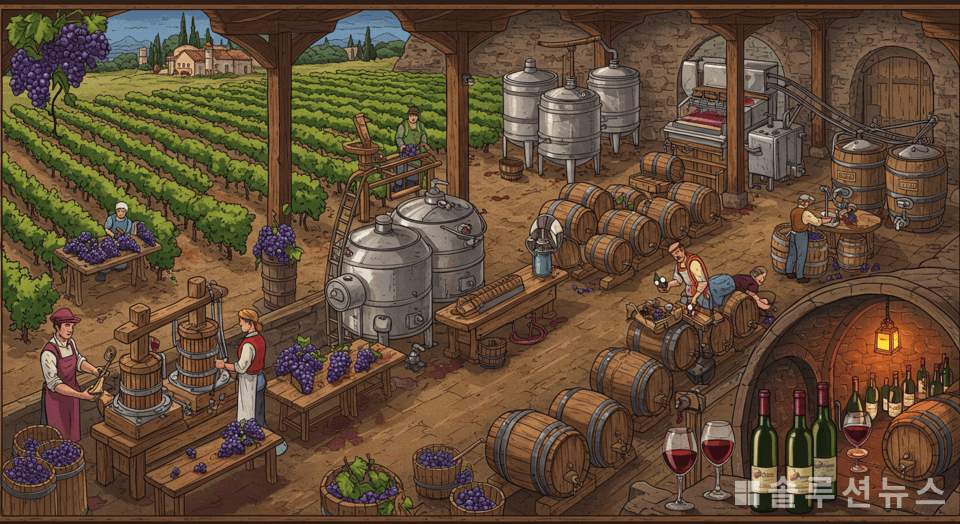“Could you please bring the menu?”
When the ‘wine list’ is opened in a fine restaurant, dozens of names and complex foreign languages overwhelm the consumer. Wine starts with grapes and is completed with aroma, taste, texture, and lingering finish. Variety comes before origin, and the character of the grape precedes the production method. Knowing which grapes are inside the bottle means you’ve understood half of the wine before even drinking it.
The character of wine comes from its skin. Red wine begins with red grapes ripened whole. ‘Tannin’ formed during fermentation leaves an astringent feeling on the tip of the tongue and creates the wine’s framework. It plays the role of firming up the taste, becoming softer the longer it ages.
Cabernet Sauvignon is a representative grape variety for making red wine. It is characterized by black fruit aroma, high acidity, and strong tannin, and pairs well with fatty meats like steak. In contrast, Merlot is softer and rounder, making it enjoyable for beginners who seek comfort.
There is also the Syrah variety. Known as Syrah in France’s Rhône region, it carries earthy notes and flavors of plums and black pepper spices. Although the same grape, it is referred to as Shiraz in Australia. Australian Shiraz is rich in sweet blackberry, chocolate, and vanilla aromas, presenting a heavier and richer impression.
Pinot Noir has thin skin, resulting in almost no tannin, with a prominent fresh cherry aroma. Its delicate taste is best enjoyed fresh rather than aged. Malbec, a signature variety of Argentina, is noted for its deep color, robust taste, and smoky aroma.

White wine speaks through its aroma. It is made from the juice of grapes with the skins removed. It presents a clear color, refreshing acidity, and predominantly fruit or floral aromas. The scent and style vary depending on the grape variety used, with Sauvignon Blanc, Chardonnay, Riesling, and Pinot Blanc as major examples.
Sauvignon Blanc boasts strong lime or grapefruit aromas, with a cooling effect in the mouth, pairing well with seafood or salads. Chardonnay’s flavor changes significantly depending on whether it is oak-aged. When made in oak barrels, it produces buttery and vanilla aromas, while stainless steel tanks give off fresh fruit aromas like apple or pear. Riesling can adjust its sweetness, transforming from dry wines to sweet dessert wines. Pinot Blanc is well-balanced in acidity and aroma, making it a versatile match with various foods.

Rosé wine is crafted through time. It uses red wine grapes but limits skin contact time to produce a light pink hue. Its acidity is clean like white wine, but it boasts the rich fruit aromas of red wine. Light and soft, it is particularly sought after in the summer. Provence in southern France is renowned worldwide for its rosé wine.
The method of production also alters the taste. Wines are categorized into four types based on production methods. The most common form is still wine, which contains no carbonation, and most red, white, and rosé wines are made this way.
Sparkling wine develops carbonation through a second fermentation process. Yeast and sugar are added to a bottle, sealed, and allowed to ferment, during which carbon dioxide dissolves in the wine to form bubbles. Champagne refers to sparkling wine produced in France’s Champagne region using this method. Even if produced similarly elsewhere, it cannot be labeled ‘Champagne.’ Prosecco, produced in Italy, undergoes secondary fermentation in large pressure tanks instead of bottles, maintaining carbonation while being lighter and more fruit-forward than Champagne.
Dessert wine is characterized by its high sweetness, often enjoyed after meals. Notable types include ice wine and noble rot wine. Ice wine is made from grapes harvested while frozen in the vineyard. When pressed in the frozen state, water content decreases, concentrating the sugars. Noble rot wine utilizes a process where mold removes water from the grapes, further condensing the sweetness and leaving a distinctive dense aroma. Both methods are heavily weather-dependent, resulting in limited production.
Fortified wine raises the alcohol content by adding brandy or grape distillate during fermentation. The early cessation of fermentation retains the sweetness, and it features intense flavors. Port wine, Sherry, and Madeira are representative examples.
